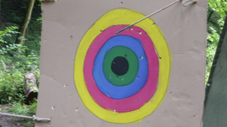For leaders in children's and youth work, it is certainly one of the most beautiful tasks to promote and use the gifts that God as Creator has given to each person. It is truly glorious to see how the Lord has placed them in individual human lives and very regrettable how much lies fallow that could actually be used for the good of all.
Basic thoughts on the project method
Teen ministry (and not only there) is not about searching for gifts, but rather about using program types and methods that bring out the gifts of the individual. Some people in our churches spend so long looking for gifts that they forget about serving. Actually, the opposite should happen, namely that the gifts serve the good of the whole. Have the courage to use the project methodology, because there is much more in our teenagers in terms of dreams, ideas and creativity than we can ever imagine. We can, may and must trust our teenagers with much, much more. Are you convinced that your teenagers can take responsibility themselves? They don't need to be very old to make decisions (including spiritual decisions)! But you have to create space for experimentation and allow the teenagers and you to make mistakes.
I will now add a few basic thoughts on the project method, the source of which is Willi Erl's book "Methoden moderner Jugendarbeit II".
When working on a project with a group, a distinction is made between various group-related project characteristics.
1. Leader-structured projects
In leader-structured projects, the leader helps the group in a way that clearly shapes the realization of the project. He introduces the topic or task. He collects ideas, opinions and questions. He distributes research and design tasks to individuals, pairs or subgroups. He has the results presented or reported to the whole group. Leader-led project work is particularly useful when groups that were previously led in a highly authoritarian manner are to be encouraged to take the initiative and act independently. To a certain extent, the process of steering the projects represents a preliminary exercise for the self-structuring application of the method.
2. Self-structured projects
The process culminates in the group members themselves shaping the projects. In the self-structured project situation, the leader stands on the sidelines of the group's activities. He observes the process and the relationships between the group members. He draws attention to the consequences of decisions if these have not been considered. They can also point out organizational necessities if they are forgotten. However, he always intervenes at the last minute, so to speak, so that he does not impair the self-development of the group and its members by moving on too quickly. The leader must be particularly careful when the group members turn to him for help. If he provides the desired help straight away, the group will get used to always seeking advice from him as soon as the work becomes more difficult. And finally, he will structure the project instead of the group.
3. Projects in self-interest or in the interest of others
In the case of leader-led projects, the question arises as to whether the group identifies with the project and accepts the undertaking as its own. In the case of self-structured projects, the question does not arise in this way; the project is an undertaking supported by the group members from the outset. Of course, this does not mean that all group members are behind it. In order to motivate the group and the individuals, but also to assess the significance of a project, it is important to gain clarity about whose interest it actually is to realize a project. We can differentiate between external interest and self-interest. Let me give you an example of each.
Project in self-interest:
A project group formed in a village to solve young people's leisure problems initially proceeds by exploring the needs and interests of the young people. A possible goal for the project group can be derived from this. It is in the young people's own interest that something meaningful comes out of it.
Project in the interest of others:
Young people organize something to help in emergency situations here in Switzerland or in developing countries. A teenage group collects money for building materials, a total of CHF 20,000, which the inhabitants of the slum use to build their own school night after night. In order for such aid to be effective, it is often necessary to undertake larger projects or to carry out a whole series of individual projects as part of an overall project. Moreover, when it comes to solidarity projects for others, the groups can be more demanding and admonishing than would be appropriate for asserting their own interests.
The decisive prerequisite for the project method is the motivation of the group members. In the case of leader-structured projects, the leader may first have to motivate the group to tackle the tasks by trying to explain the purpose, benefits and significance of the project. In the case of self-structured undertakings, the leader sometimes has the task of encouraging the group to complete the work they have started.
When you work on projects, you work with your teenagers towards a goal. Set as broad a framework as possible so that the young people can do as much as possible themselves. The project methodology will play an increasingly important role in our programs in the coming years, because here God and his gifts, which he has given to each individual, are taken seriously.
I have been working primarily with project methodology in my camps for several years now. Since then, many more teenagers have decided to live a life with Jesus. This is certainly not only, but also due to the project-based work. The teenagers feel that the gifts God has given them are good and that they can use and develop them. They now want to trust this Lord, who has created them with these wonderful gifts and always takes them seriously, this Creator who means so well with them, and even entrust themselves completely to Him.
When I work with the project methodology, I take this Lord seriously, who has put so much into our teenagers. I take these teenagers seriously, whom God loves so much, and I take his mission seriously because I want to give the best.
References
Content: Hansjörg Kaufmann based on the book by Willi Erl "Methods of Modern Youth Work II"
copyright: BESJ Fällanden www.besj.ch
Picture: Juropa .net www.juropa.net
Content may be automatically translated. Help improve the quality of the translation with your editing!



